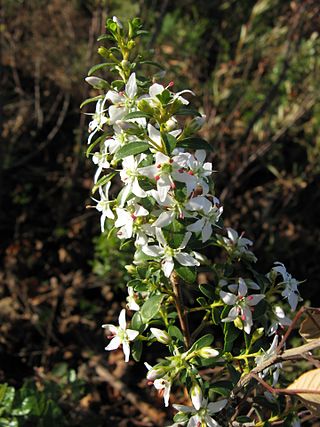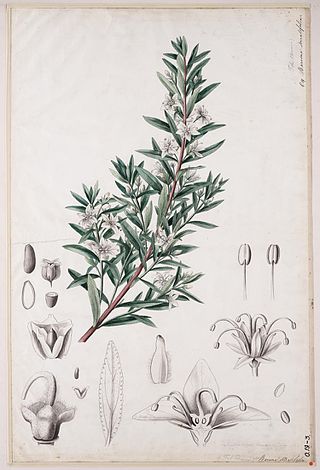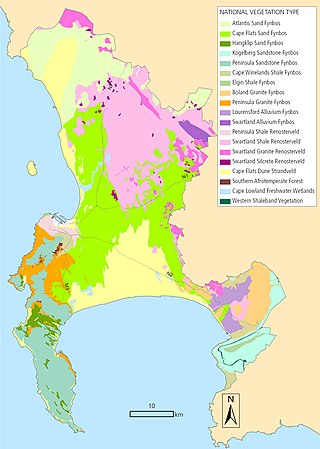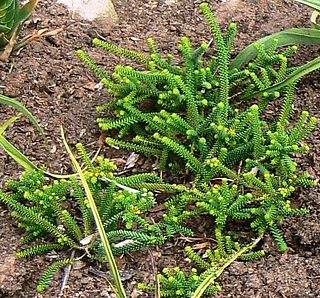
The Rutaceae is a family, commonly known as the rue or citrus family, of flowering plants, usually placed in the order Sapindales.

Citrus hystrix, called the kaffir lime or makrut lime, is a citrus fruit native to tropical Southeast Asia.

The curry tree, Murraya koenigii or Bergera koenigii, is a tropical and sub-tropical tree in the family Rutaceae, native to Asia. The plant is also sometimes called sweet neem, though M. koenigii is in a different family to neem, Azadirachta indica, which is in the related family Meliaceae.

Agathosma is a genus of about 140 species of flowering plants in the family Rutaceae, native to the southern part of Africa. Common names include Buchu, Boegoe, Bucco, Bookoo and Diosma. Buchu formally denotes two herbal species, prized for their fragrance and medicinal use despite their toxicity. In colloquial use however, the term is applied to a wider set of fragrant shrubs or substitutes.

Adenandra is a genus of evergreen shrubs of the family Rutaceae, commonly known as buchu. The genus is native to South Africa. The plants are related to the citrus family, and have oil glands in the leaves which give off a distinctive aroma. The name Adenandra derives from Greek aden, a gland; ander, a man. The leaves are small and almost scale-like, being sessile or subsessile. The conspicuous flowers have five petals, and are pink or white. Adenandra are cultivated by gardeners for their ornamental and aromatic value.

Agathosma betulina is a flowering plant in the family Rutaceae, native to the lower elevation mountains of western South Africa, where it occurs near streams in fynbos habitats.

Agathosma crenulata is a flowering plant in the family Rutaceae, native to the lower elevation mountains of southwestern South Africa, where it occurs near streams in fynbos habitats. It is an evergreen shrub growing to 1.5-2.5 m tall. The leaves are opposite, oval, 15–35 mm long and 7–18 mm broad. The flowers are white or pale pink, with five petals; the fruit is a five-parted capsule which splits open to release the seeds.

Namul refers to either a variety of edible grass or leaves or seasoned herbal dishes made of them. Wild greens are called san-namul, and spring vegetables are called bom-namul. On the day of Daeboreum, the first full moon of the year, Koreans eat boreum-namul with five-grain rice. It is believed that boreum namuls eaten in winter help one to withstand the heat of the summer to come.

Coleonema is a genus of flowering plants in the family Rutaceae. The eight known species are all from the western Cape Province of South Africa. In Australia, where they are cultivated as garden ornamentals, they are often referred to as Diosma, a different genus in the same family.

Agathosma serratifolia, known as longleaf buchu or long buchu, is an erect, South African shrub, belonging to the citrus family Rutaceae. It is one of about 135 species mainly occurring in the south-western Cape Province. There, it is found on mountain slopes, wooded ravines, and valleys. The leaves are simple, ovoid, slightly serrated, and 0.5-3.5cm long. In April and May, the plant produces 5-petalled flowers. 'Agathosma' = 'good smell', 'serratifolia' = 'serrate leaved'.

Hippobromus pauciflorus, commonly known as false horsewood, is a small South African semi-deciduous tree occurring on the margins of forest, stream banks and in scrub forest. Frequently growing as a tall, slender sapling and accordingly prized as wattle for hut-building. Leaves 75 mm to 150 mm long, paripinnate with some 5 pairs of leaflets which are extremely variable in shape, wedge-shaped at the base, entire, dentate or deeply lobed, sessile and winged on the rachis between leaflets. Panicles up to 75 mm long and many-flowered. Fruits are about 8 mm in diameter, black, pulpy and unpalatable. All parts of the tree have an unpleasant odour when bruised. Fourcade describes the wood as "very heavy and hard, very strong, moderately elastic, close-grained ... heartwood brown, sapwood white, tinged with brown, used for wagon-work and other purposes. The wood and leaves contain a strongly scented resinous and oily substance, which renders them readily inflammable." This tree is found along the east coast from the Eastern Cape, through KwaZulu Natal, Eswatini and further inland through the Transvaal up to the Soutpansberg.
Boegoe is a word of Khoikhoi origin, which may refer to a number of South African plants, fungi or a mineral, that were used in traditional preparations. Most Boegoe plants are typified by a strong aromatic odour due to volatile oils released by glands in the leaves. The name primarily denotes those plant species of which the stems, powdered leaves or volatile oils are employed in herbalism.

The Biodiversity of Cape Town is the variety and variability of life within the geographical extent of the City of Cape Town metropolitan municipality, excluding the Prince Edward Islands. The terrestrial vegetation is particularly diverse and much of it is endemic to the city and its vicinity. Terrestrial and freshwater animal life is heavily impacted by urban development and habitat degradation. Marine life of the waters immediately adjacent to the city along the Cape Peninsula and in False Bay is also diverse, and while also impacted by human activity, the habitats are relatively intact.

Agathosma gonaquensis is a species of plant in the family Rutaceae. Its habitat is restricted to a tiny area of the Eastern Cape, South Africa. According to the South African National Biodiversity Institute, it is critically endangered.

Buddleja agathosma is a deciduous shrub endemic to western Yunnan, China. Originally identified as B. agathosma by Ludwig Diels, it was sunk as Buddleja crispa by Leeuwenberg in 1979, and treated as such in the subsequent Flora of China published in 1996. However, the shrub remains widely known by its former epithet in horticulture.

Pseudodictamnus mediterraneus, the false dittany, is a species of flowering plant in the mint family Lamiaceae. It is native to the southern Aegean region.
Zanthoxyloideae is a subfamily of the family Rutaceae.
Diosma haelkraalensis, or Hagelkraal's diosma, is a rare species of plant from South Africa.














